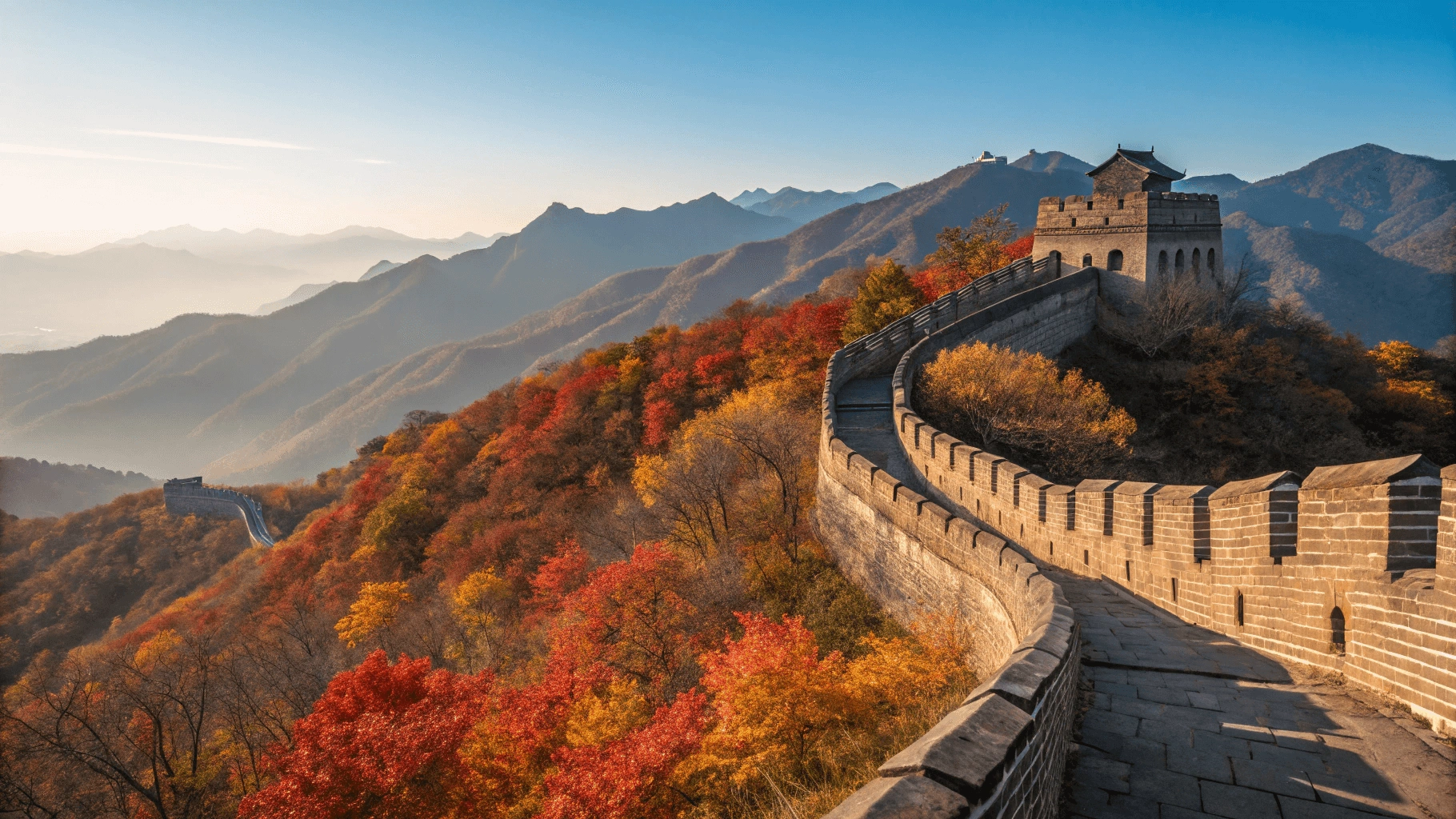When planning a trip to China, timing can be everything. This vast country—spanning roughly the same land area as the United States—encompasses diverse climate zones from the freezing northern reaches of Harbin to the tropical beaches of Hainan Island. With such geographical diversity, there’s no single perfect time to visit all of China.
This comprehensive guide breaks down the best times to visit based on regions, seasons, and your specific interests. Whether you’re looking to avoid crowds, traveling on a budget, or seeking the perfect weather for hiking the Great Wall, we’ve got you covered with actionable advice drawn from years of experience organizing travel throughout China.
Table of Contents
Quick Answer: Best Time to Travel to China
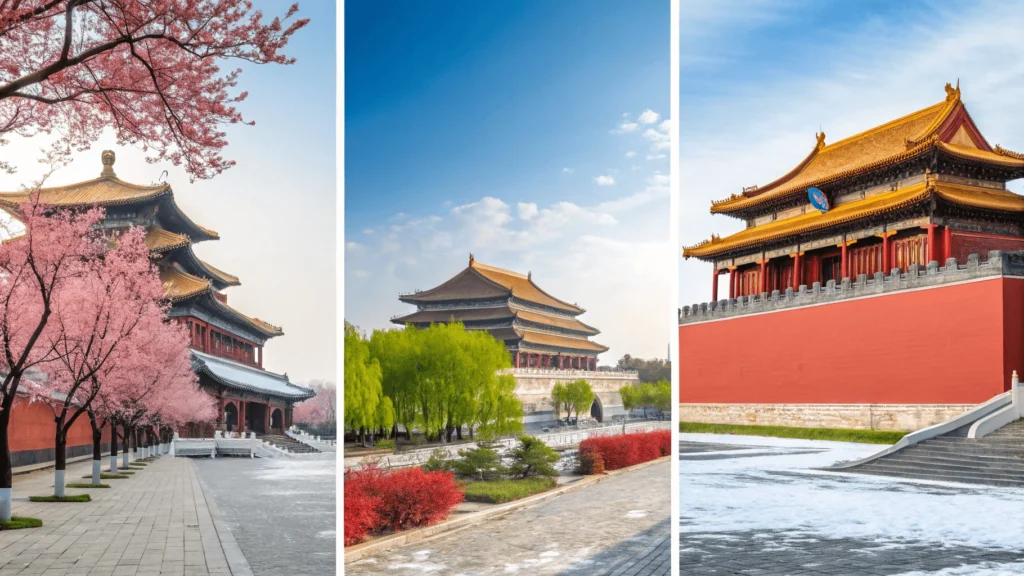
Overall Best Times: Spring (April-May) and Autumn (September-October) offer the most pleasant weather for most regions with comfortable temperatures and less rainfall.
Best Budget Times: Consider shoulder seasons (late March, June, early September, November) or winter months (excluding holidays) for significant savings, though weather conditions may be less ideal. “best time to travel to china”
Times to Potentially Avoid: Major National Holidays (especially Golden Weeks in May and October), peak summer in eastern regions (heat/humidity/rain), and extreme winter in northern areas unless you’re specifically seeking winter activities.
Understanding China’s Climate: It’s Bigger Than You Think!

China’s sheer size means it encompasses multiple climate zones that experience dramatically different conditions simultaneously:
- Northern China (Beijing, Harbin): Four distinct seasons with hot summers and freezing winters
- Southern China (Guangzhou, Hong Kong): Subtropical with mild winters and hot, humid summers
- Western China/Tibetan Plateau (Lhasa, Xinjiang): High-altitude desert climate with large temperature variations
- Northwestern China (Xinjiang, Gansu): Arid with extreme temperatures in both summer and winter
This climate diversity explains why there’s no single “best time to travel to china” to visit China—your ideal timing depends entirely on which regions you plan to explore. For a detailed breakdown of China’s regional climate data, consult the Climate Data from the China Meteorological Administration which provides authoritative insights across provinces. “best time to travel to china”
Best Time to Visit China by Season (Detailed Breakdown)
Spring (March – May): Blooming Opportunities

Overall Weather: Spring brings warming temperatures across China, with generally pleasant conditions and occasional rainfall. The season progresses from cool to increasingly warm. “best time to travel to china”
Pros:
- Spectacular flower blooms (cherry blossoms, peonies, rapeseed fields)
- Comfortable temperatures for extensive sightseeing
- Lush green landscapes as nature awakens
- Generally good visibility in most regions
Cons:
- Weather can be variable and unpredictable
- Northern regions may experience sandstorms (particularly March-April)
- Tourist crowds begin to increase as peak season approaches
- Rain becomes more frequent as spring progresses
Regional Focus:
- Northern China: Cool early spring, pleasant by May
- Central China: Near-perfect temperatures for outdoor activities
- Southern China: Already warm and increasingly humid
- Western China: Still quite cold in high-altitude areas early spring
Best Activities:
- City tours in Beijing, Xi’an, and Shanghai
- Beginning of Yangtze River cruise season
- Hiking in Yellow Mountains (Huangshan)
- Visiting gardens and parks for flower displays
- Exploring the countryside as farmers plant rice and other crops
Key Events/Holidays:
- Qingming Festival (April 4-6) – Moderate crowds
- May Day Holiday (May 1-5) – Heavy crowds, advance booking essential
- Learn more about the customs and origins of the Qingming Festival from China Highlights, a respected travel and culture resource. “best time to travel to china”
Summer (June – August): Heat, Rain & Peak Season
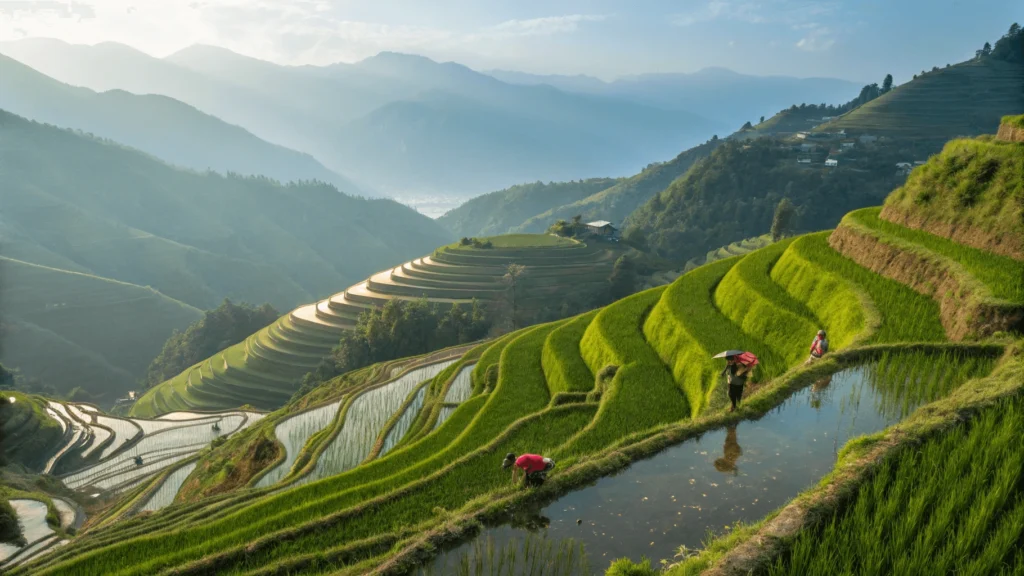
Overall Weather: Hot and humid across much of China, with regular rainfall in eastern and southern regions. This is also the typhoon season for coastal areas. “best time to travel to china”
Pros:
- Ideal weather for high-altitude destinations like Tibet and Qinghai
- Vibrant green landscapes with abundant vegetation
- Longer daylight hours for sightseeing
- Perfect for visiting grasslands of Inner Mongolia
Cons:
- Extreme heat and humidity in eastern and southern regions
- Heavy rainfall and potential flooding in central and southern areas
- Peak tourist season with higher prices and larger crowds
- Typhoon risk along eastern and southern coasts
Regional Focus:
- Northern China: Hot but generally less humid
- Eastern/Southern China: Hot, humid with frequent rainfall
- Western Plateaus: Pleasant temperatures, best season to visit
- Northwest: Hot and dry, potentially uncomfortable
Best Activities:
- Tibet and Silk Road explorations
- Inner Mongolia grassland tours
- High-altitude hiking in Jiuzhaigou (check current access)
- Mountain retreats to escape lowland heat
- Southern China rice terrace viewing (filled with water)
- Visit the official Harbin International Ice and Snow Sculpture Festival website for up-to-date schedules and ticket info.
Key Events/Holidays:
- Dragon Boat Festival (June, dates vary by lunar calendar)
- Various local festivals throughout summer months
Autumn (September – October): Golden Season
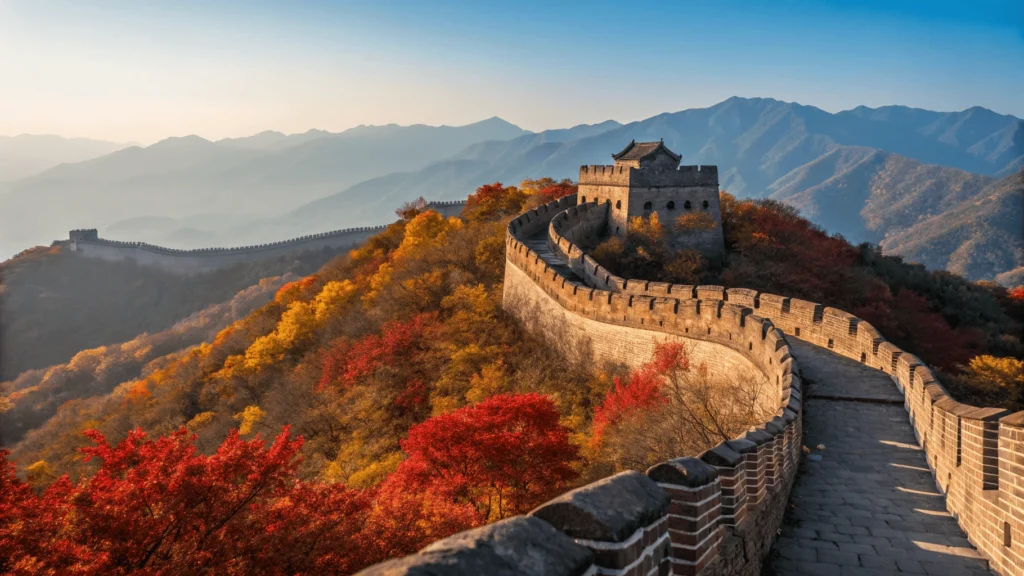
Overall Weather: Widely considered the best season overall with clear skies, comfortable temperatures, and reduced rainfall across most of China. “best time to travel to china”
Pros:
- Spectacular fall colors, especially in northern and central regions
- Mild temperatures ideal for long days of exploration
- Excellent visibility for photography
- Less rainfall than spring or summer
Cons:
- Extreme crowds during October National Day Golden Week
- Growing popularity means advance booking essential
- Premium pricing during peak autumn periods
Regional Focus:
- Nearly ideal conditions across all regions
- Northern China: Crisp, cool days with spectacular fall foliage
- Central China: Perfect weather for outdoor activities
- Southern China: Reduced humidity and rainfall
Best Activities:
- Hiking sections of the Great Wall
- City explorations without weather extremes
- Photographing Guilin and Yangshuo karst landscapes
- National park visits for fall colors
- Enjoying outdoor tea houses and meals
Key Events/Holidays:
- Mid-Autumn Festival (September/October, lunar calendar)
- National Day Golden Week (October 1-7) – MASSIVE crowds, avoid unless necessary
Winter (November – February): Cold, Clear & Festive
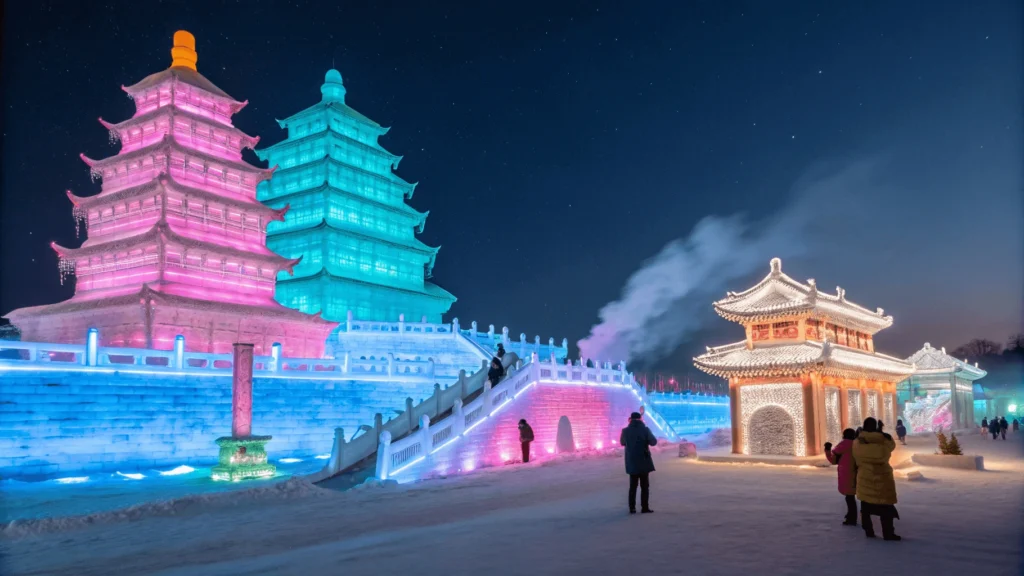
Overall Weather: Cold throughout most of China, with freezing temperatures in the north, snow in mountainous regions, and milder conditions in the far south. “best time to travel to china”
Pros:
- Fewer tourists at major attractions (outside holiday periods)
- Significantly lower prices for accommodations and flights
- Stunning snow scenery in northern regions
- Clear skies in many areas with good visibility
- Unique winter-only experiences like ice festivals
Cons:
- Extreme cold in northern and western regions
- Some attractions may have reduced hours or limited access
- Potential travel disruptions due to snow or ice
- Less vibrant landscapes in many regions
Regional Focus:
- Northern China: Freezing temperatures, snow, and ice
- Central China: Cold and sometimes damp
- Southern China: Mild temperatures with occasional cool days
- Yunnan/Hainan: Remain relatively warm, good winter escapes
Best Activities:
- Harbin Ice and Snow Festival (January-February)
- Winter sports in northern ski resorts
- Experiencing Chinese New Year celebrations (with planning)
- Hot spring visits
- Southern escapes to Yunnan or Hainan for warmth
Key Events/Holidays:
- Chinese New Year/Spring Festival (January/February by lunar calendar) – Major holiday period with mass migration, many business closures, but unique cultural experiences “best time to travel to china”
Best Time to Visit China by Region (Quick Guide)
Beijing & North China
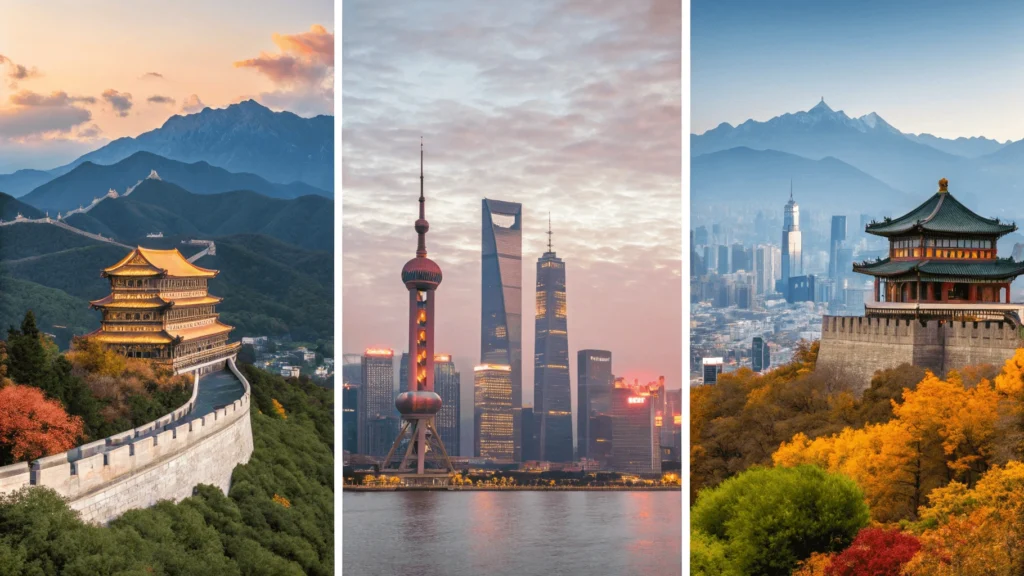
Best: Spring (April-May), Autumn (September-October) Avoid: Deep Winter (December-February) unless seeking winter activities, sandstorm season (March) Note: Beijing offers clear skies and good air quality often in winter, despite the cold “best time to travel to china”
Shanghai & East China
Best: Spring (April-May), Autumn (September-October) Avoid: Peak Summer (July-August) due to heat/humidity/typhoon risk, potentially damp winter Note: Shanghai winters are damp rather than freezing, which can feel colder than the temperature suggests
Xi’an & Central China
Best: Spring (April-May), Autumn (September-October) Avoid: Summer heat extremes, winter chill Note: Xi’an can be very hot in summer but offers amazing evening street food scenes “best time to travel to china”
Guilin, Yangshuo & South China
Best: Autumn (September-November) for dry conditions, Spring (April-May) Caution: Summer (June-August) brings heavy rainfall, Winter (December-February) is cool and sometimes damp Note: Water levels on Li River affect boat cruises; higher in summer, lower in winter
Yunnan Province
Good year-round depending on altitude, but Spring (March-May) & Autumn (September-October) are often ideal Note: Kunming is known as the “City of Eternal Spring” with mild year-round temperatures
Tibet & High Plateaus
Best: Late Spring (May) to Early Autumn (October) Avoid: Winter (November-April) brings extreme cold, limited access, and many closures Note: Permits required for foreign visitors; impossible to visit without proper arrangements, Foreign travelers can review current travel policies and permit requirements via the Tibet Tourism Bureau. “best time to travel to china”
Silk Road & Northwest
Best: Late Spring (May-June), Autumn (September-October) Avoid: Extreme summer heat in desert regions, extreme winter cold Note: Temperature variations between day and night can be dramatic; pack accordingly
Best Time for Specific Activities & Interests

Hiking the Great Wall
Ideal: Spring (April-May), Autumn (September-October) Why: Comfortable temperatures, good visibility, and beautiful surrounding landscapes “best time to travel to china”
Yangtze River Cruise
Ideal: Spring (April-May), Autumn (September-October) Why: Pleasant temperatures, less rainfall, good visibility for scenery
Seeing Giant Pandas (Chengdu)
Year-round, but cooler months (March-May, September-November) often show more active pandas Note: Pandas are typically most active in the morning hours
Harbin Ice & Snow Festival
Ideal: January-February only Why: Festival typically runs from late December to late February, with prime viewing in January
Beach Time (Hainan)
Ideal: Autumn (October-November), Winter (December-February), Spring (March-April) Avoid: Summer typhoon season (June-September) Note: Winter is peak season with higher prices but perfect beach weather “best time to travel to china”
Cultural Festivals
Chinese New Year: January/February (lunar calendar) Mid-Autumn Festival: September/October (lunar calendar) Dragon Boat Festival: June (lunar calendar) Note: Experiencing authentic festivals requires advance planning around transportation challenges
Budget Travel
Ideal: Shoulder seasons (March, November), Winter (excluding Chinese New Year) Why: Lower accommodation costs, fewer tourists, cheaper flights
Avoiding Crowds
Ideal: Winter (excluding Chinese New Year), early June, late November Absolute must: Avoid Golden Weeks (May 1-5, October 1-7) and Chinese New Year period “best time to travel to china”
Month-by-Month Guide

January
- Weather: Very cold in north, cool in center, mild in deep south
- Highlights: Harbin Ice Festival, winter sports, Hainan beaches
- Considerations: Chinese New Year may fall in January (varies by year)
February
- Weather: Cold throughout most of China, warming slightly from January
- Highlights: Chinese New Year celebrations (typically), winter sports
- Considerations: Major travel disruptions during Spring Festival
March
- Weather: Warming up but still cool, potential sandstorms in north
- Highlights: Early spring blooms in central and southern regions
- Considerations: Good value travel before peak season
April
- Weather: Pleasant in most regions, spring in full swing
- Highlights: Spring flowers, comfortable sightseeing temperatures
- Considerations: Qingming Festival brings moderate domestic tourism
May
- Weather: Warm throughout China, increasing humidity in south
- Highlights: Perfect for most regions before summer heat
- Considerations: May Holiday (1-5) brings major crowds
June
- Weather: Hot in most regions, rainy season begins in many areas
- Highlights: Good for high-altitude destinations, Dragon Boat Festival
- Considerations: Early June (after holiday, before school break) offers good value
July
- Weather: Hot and humid across eastern China, rain frequent
- Highlights: Tibet, Xinjiang, Inner Mongolia at their best
- Considerations: School holidays bring domestic tourism increase
August
- Weather: Peak heat and humidity, typhoon risk on coast
- Highlights: High-altitude destinations, grasslands
- Considerations: Peak domestic tourism season
September
- Weather: Cooling down, decreasing rainfall, excellent conditions
- Highlights: Mid-Autumn Festival, perfect for most destinations
- Considerations: Early September (after school starts) sees fewer crowds
October
- Weather: Clear and comfortable throughout most of China
- Highlights: Fall foliage, perfect weather for outdoor activities
- Considerations: National Day Golden Week (1-7) brings extreme crowds
November
- Weather: Cooling significantly, early winter in north, pleasant in south
- Highlights: Late autumn colors, fewer tourists
- Considerations: Great value travel month before winter
December
- Weather: Winter conditions in most regions, cold but often clear
- Highlights: Early winter scenes, Christmas celebrations in major cities
- Considerations: Prices rise toward end of month for holidays
Key Factors to Consider: Crowds, Costs & Holidays
Chinese National Holidays (The Big Ones)
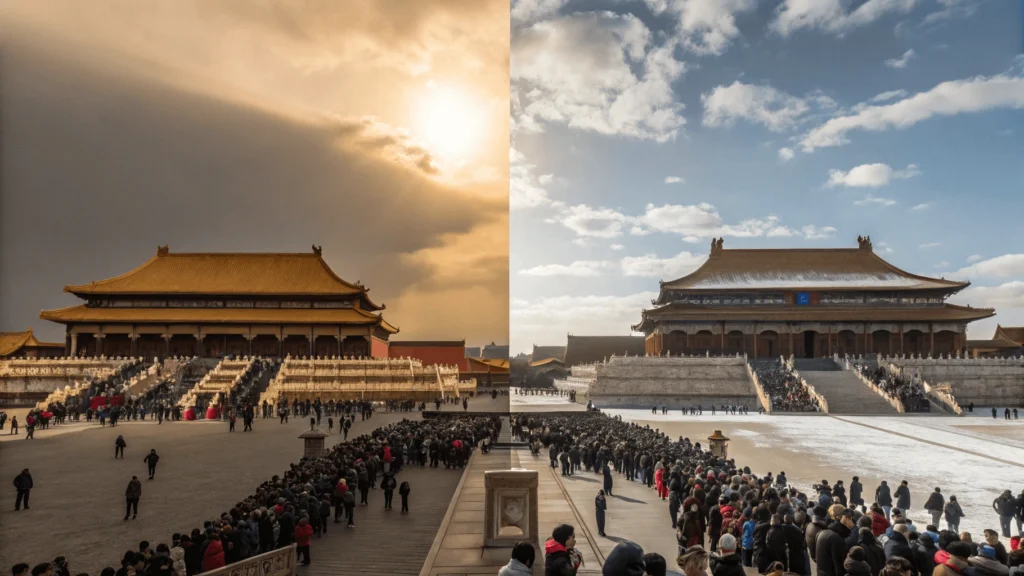
China’s “Golden Weeks” create the most significant travel challenges for visitors:
- Spring Festival/Chinese New Year (January/February, dates vary) – The world’s largest annual human migration creates transportation nightmares, business closures, and accommodation scarcity.
- National Day Golden Week (October 1-7) – Domestic tourism peaks with hundreds of millions traveling simultaneously, creating crowds at all major attractions.
Impact: Extreme crowds, transportation sell-outs (often months in advance), significantly higher prices, and reduced experience quality at major attractions. “best time to travel to china”
Recommendation: Either book everything many months in advance or completely avoid these periods.
Other Important Chinese Holidays
- Qingming Festival (April 4-6) – Moderate impact
- May Day/Labor Day (May 1-5) – Significant impact
- Dragon Boat Festival (June, lunar calendar) – Moderate impact
- Mid-Autumn Festival (September/October, lunar calendar) – Moderate impact
School Holidays
Chinese school holidays bring increased domestic tourism:
- Winter Break: January-February (coincides with Spring Festival)
- Summer Break: July-August
- Various shorter breaks throughout year
Cost Variation
Price fluctuations can be dramatic depending on timing:
- Peak Season (major holidays, summer): Prices may double or triple
- Shoulder Season (spring/autumn outside holidays): Moderate prices
- Off-Season (winter excluding CNY): Best values available
A typical 4-star hotel might cost:
- 1500 RMB during Golden Week
- 800 RMB during regular peak season
- 500 RMB during off-season
Crowd Levels
Crowd intensity varies dramatically:
- Extreme: Chinese New Year, National Day Golden Week
- Heavy: Summer holidays, May Holiday
- Moderate: Regular weekends, minor holidays
- Light: Weekdays during non-holiday periods, winter (except CNY)
Practical Tips Based on Timing Your Trip
Packing Recommendations
Spring: Layerable clothing (temperatures vary significantly)
- North: Light coat, sweaters, long pants
- South: Light layers, rain gear
Summer: Light, breathable clothing, sun protection
- Everywhere: Sun hat, sunscreen, light fabrics
- Central/South: Rain gear, quick-dry clothing
Autumn: Light layers, light jacket for evenings
- North: Warmer jacket for late autumn
- South: Light layers sufficient most days
Winter: Serious cold-weather gear for most regions
- North: Heavy coat, thermal layers, gloves, hat, scarf
- South: Medium jacket, sweaters, layers
Booking Recommendations
Golden Weeks (CNY, National Day):
- Flights: 4-6 months in advance
- Hotels: 3-4 months in advance
- Train tickets: As soon as booking window opens (usually 60 days)
Regular Peak Season (summer, major holidays):
- Flights: 2-3 months in advance
- Hotels: 1-2 months in advance
- Train tickets: 30-60 days in advance
Shoulder/Off-Season:
- Flights: 1-2 months in advance for best prices
- Hotels: 2-4 weeks often sufficient
- Train tickets: 1-2 weeks in advance (except for major routes)
Visa Application Timing
- Apply 1-2 months before planned travel
- Processing typically takes 4-7 business days
- Express service available in many countries (additional fee)
- Consider seasonal consulate workloads (slower during peak travel seasons)
Expert Insights & Why Trust This Guide
With over a decade of experience organizing specialized tours throughout China’s diverse regions, we’ve seen firsthand how timing can make or break a China experience. Our local experts live and work across China’s major tourism regions, providing real-time insights into conditions and crowd levels throughout the year.”best time to travel to china”
One insider tip rarely mentioned: consider visiting Beijing in winter! While cold, this season often brings the clearest blue skies, dramatically reduced crowds at major attractions like the Forbidden City, and opportunities to see the Great Wall dusted with snow—a photographer’s dream and an experience most visitors miss.”best time to travel to china”
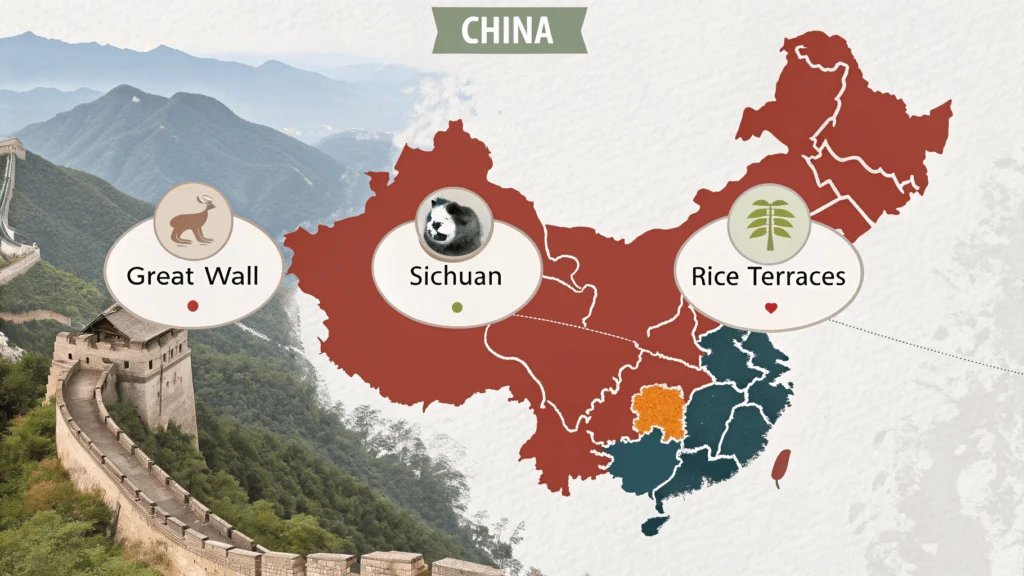
Frequently Asked Questions
What is the absolute cheapest time to visit China?
Late November through early December offers the best combination of reasonable weather and rock-bottom prices (excluding the far north). January and February (outside Chinese New Year) also offer excellent values, though weather limits some activities.
Is China safe to visit?
China ranks among the safest countries for travelers in terms of crime. Standard travel precautions apply, and visiting China is generally very safe. Health considerations vary by season and region. Refer to the U.S. Department of State Travel Advisory for up-to-date safety, health, and security guidance for visitors to China.
How long do I need to visit China?
For first-time visitors covering major highlights (Beijing, Xi’an, Shanghai), allow at least 8-10 days. To include additional regions like Guilin or Sichuan, 14+ days is recommended. China’s size makes rushed itineraries particularly exhausting.
What is the rainy season in China?
The rainy season varies by region but generally affects eastern and southern China from April through September, with June-August seeing the heaviest rainfall. Northwestern China remains dry year-round.
Is it better to visit China in Spring or Autumn?
Autumn generally offers more reliable weather with less rainfall and more comfortable temperatures. However, spring brings flowering landscapes and fewer crowds outside the May holiday period. Both are excellent choices with autumn having a slight advantage for most travelers.
Conclusion “best time to travel to china”
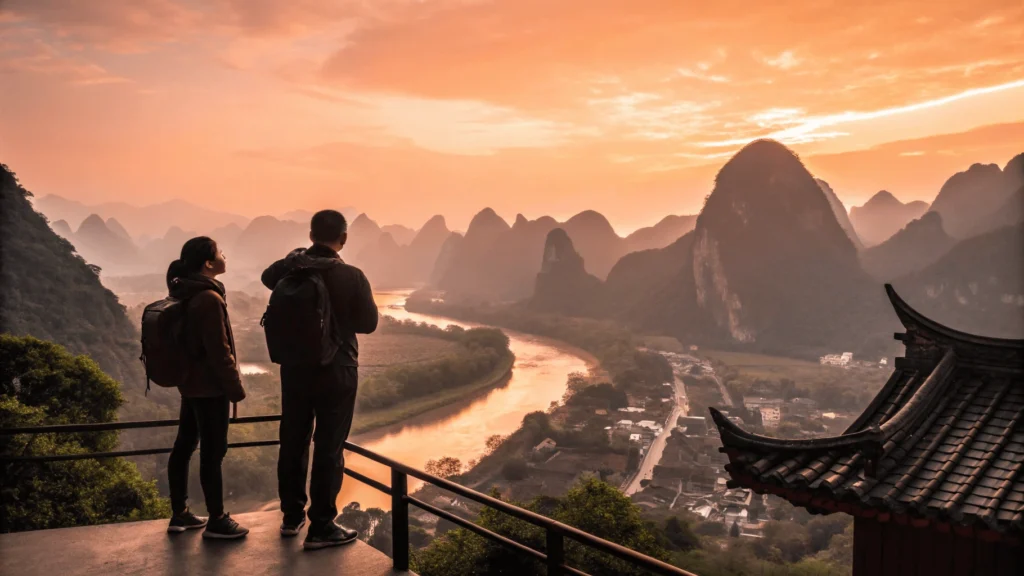
The best time to travel to China ultimately depends on your specific interests, regional focus, and tolerance for various weather conditions. Spring (April-May) and autumn (September-October) provide the most reliable pleasant conditions across most regions, though each season offers unique experiences worth considering. “best time to travel to china”
When planning your China adventure, prioritize your must-see destinations and activities, then select your timing accordingly. Remember that avoiding major Chinese holidays will significantly enhance your experience at popular attractions.”best time to travel to china”
Ready to make your China journey a reality? Explore our detailed regional guides and customized itineraries to match the perfect timing with your travel dreams.

